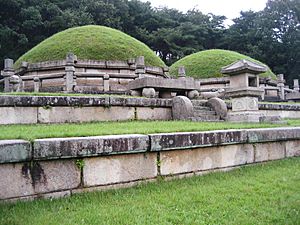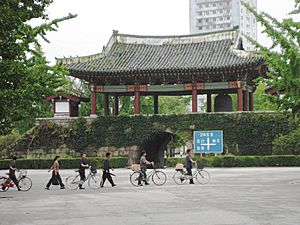Historic Monuments and Sites in Kaesong facts for kids
The historic monuments and sites in Kaesong are amazing old places in North Korea. They show us the history of the Koryo Dynasty. This was a powerful kingdom that ruled Korea from 918 CE to 1392 CE. In 2013, these sites were chosen as a UNESCO World Heritage Site. This means they are very important to the whole world.
Kaesong was the capital city of the Koryo Kingdom. The city's old gates, palaces, tombs, and schools are all part of this special site. They show us how the Koryo people lived and what they believed. This includes their ideas about politics, culture, and religion. The city's design mixes ideas from Buddhism, Taoism, and Confucianism. It especially shows how beliefs changed from Buddhism to neo-Confucianism during the Koryo Dynasty.
Contents
City Walls and Gates
The UNESCO World Heritage Site includes three different parts of the city wall. It also includes some important gates in Kaesong.
The Old Walls
The Palocham Wall was built in 896 CE. This was just before the Koryo Dynasty began. The Outer Wall was built later, between 1009 and 1029. It connected the city to nearby mountains like Songak and Ryongsu. This wall helped defend the city. It also showed what people believed about the spiritual power of mountains. The Inner Wall was built in 1391-1393. This was right at the end of the Koryo Dynasty.
Namdae Gate
The Namdae Gate was the main gate on the south side of Kaesong. It was part of the Inner Wall.
Royal Palaces and Schools
Many important buildings from the Koryo Dynasty are part of the site. These include palaces and places of learning.
Manwoldae Palace
Manwoldae Palace was the royal palace for 500 years. It is now an archaeological site, meaning it is in ruins. The palace burned down four times, but people kept rebuilding it. Today, teams from North and South Korea work together to study this important site.
Kaesong Chomsongdae
The ruins of the Kaesong Chomsongdae are also part of the site. This was an observatory tower. People used it to study the stars and the weather.
Important Schools
The Koryo Songgyungwan was a special school. Government officials were trained there. Sungyang Sowon was another school that taught Confucian philosophy.
Sonjuk Bridge
Sonjuk Bridge is a famous spot. A high official named Jong Mong Ju was killed there. This event was an important part of the end of the Koryo Dynasty.
Tombs and Monuments
The Heritage Site also includes many tombs and monuments. These honor important people from the Koryo Dynasty.
Royal Tombs
The site has large tombs for two kings: King Wang Kon and King Kongmin. There are also two other groups of tombs. These are called the Seven Tombs Cluster and the Myongrung Tombs Cluster.
Phyochung Monuments
There are two steles for Jong Mong Ju. These are called the Phyochung Monuments. Steles are like memorial pillars. They often have a person's name written on them. However, they do not contain the person's body.



